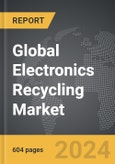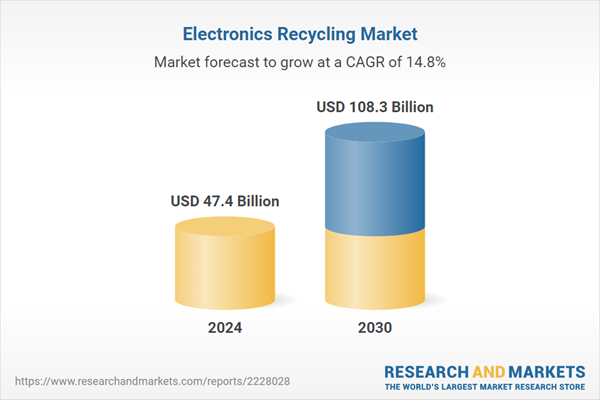The global market for Electronics Recycling was valued at US$47.4 Billion in 2024 and is projected to reach US$108.3 Billion by 2030, growing at a CAGR of 14.8% from 2024 to 2030. This comprehensive report provides an in-depth analysis of market trends, drivers, and forecasts, helping you make informed business decisions. The report includes the most recent global tariff developments and how they impact the Electronics Recycling market.
The rise in electronic device usage has led to a significant increase in e-waste, prompting stricter regulations and more robust recycling initiatives worldwide. Governments and environmental organizations are advocating for extended producer responsibility (EPR), where manufacturers are required to manage the end-of-life disposal of their products. This has led to the establishment of take-back programs and recycling incentives. Additionally, public awareness campaigns aim to educate consumers on the importance of recycling electronics and the environmental impact of improper disposal. Technological advancements have also improved the efficiency of recycling processes. Innovations in automated sorting and material recovery technologies have made it possible to handle larger volumes of e-waste more effectively, enhancing the economic viability of recycling operations.
The growth in the electronics recycling market is driven by several factors, including increasing e-waste generation, stringent environmental regulations, and rising consumer awareness. The rapid pace of technological advancements and the frequent upgrading of electronic devices result in a steady increase in e-waste. Regulations mandating the proper disposal and recycling of electronic products, particularly in developed regions, have spurred the establishment of recycling infrastructure. Furthermore, growing consumer awareness about the environmental and health impacts of e-waste has led to higher participation in recycling programs. The market is also benefiting from the circular economy model, where the focus is on designing products with longer life cycles and better recyclability. Additionally, advancements in recycling technologies are improving the efficiency and profitability of e-waste recycling operations. As these factors converge, the electronics recycling market is poised for substantial growth, driven by the need to manage e-waste sustainably and the economic opportunities presented by material recovery.
Segments: Material (Metals, Plastics, Other Materials); Equipment Type (Consumer Electronics, IT & Telecom, Other Equipment Types).
Geographic Regions/Countries: World; USA; Canada; Japan; China; Europe; France; Germany; Italy; UK; Spain; Russia; Rest of Europe; Asia-Pacific; Australia; India; South Korea; Rest of Asia-Pacific; Latin America; Argentina; Brazil; Mexico; Rest of Latin America; Middle East; Iran; Israel; Saudi Arabia; UAE; Rest of Middle East; Africa.
The analysts continuously track trade developments worldwide, drawing insights from leading global economists and over 200 industry and policy institutions, including think tanks, trade organizations, and national economic advisory bodies. This intelligence is integrated into forecasting models to provide timely, data-driven analysis of emerging risks and opportunities.
Global Electronics Recycling Market - Key Trends & Drivers Summarized
Electronics recycling is an increasingly crucial aspect of waste management and environmental sustainability, addressing the growing problem of electronic waste (e-waste). E-waste includes discarded electronic devices such as smartphones, computers, televisions, and household appliances, many of which contain hazardous materials like lead, mercury, and cadmium. Proper recycling of these items not only prevents these toxic substances from contaminating the environment but also recovers valuable materials like gold, silver, and copper. The recycling process involves several steps, including collection, sorting, dismantling, and extraction of materials. Advanced recycling facilities use techniques such as shredding, magnetic separation, and chemical processing to efficiently recover and purify these materials. By doing so, electronics recycling helps conserve natural resources, reduces greenhouse gas emissions, and minimizes the ecological footprint of electronic devices.The rise in electronic device usage has led to a significant increase in e-waste, prompting stricter regulations and more robust recycling initiatives worldwide. Governments and environmental organizations are advocating for extended producer responsibility (EPR), where manufacturers are required to manage the end-of-life disposal of their products. This has led to the establishment of take-back programs and recycling incentives. Additionally, public awareness campaigns aim to educate consumers on the importance of recycling electronics and the environmental impact of improper disposal. Technological advancements have also improved the efficiency of recycling processes. Innovations in automated sorting and material recovery technologies have made it possible to handle larger volumes of e-waste more effectively, enhancing the economic viability of recycling operations.
The growth in the electronics recycling market is driven by several factors, including increasing e-waste generation, stringent environmental regulations, and rising consumer awareness. The rapid pace of technological advancements and the frequent upgrading of electronic devices result in a steady increase in e-waste. Regulations mandating the proper disposal and recycling of electronic products, particularly in developed regions, have spurred the establishment of recycling infrastructure. Furthermore, growing consumer awareness about the environmental and health impacts of e-waste has led to higher participation in recycling programs. The market is also benefiting from the circular economy model, where the focus is on designing products with longer life cycles and better recyclability. Additionally, advancements in recycling technologies are improving the efficiency and profitability of e-waste recycling operations. As these factors converge, the electronics recycling market is poised for substantial growth, driven by the need to manage e-waste sustainably and the economic opportunities presented by material recovery.
Report Scope
The report analyzes the Electronics Recycling market, presented in terms of units. The analysis covers the key segments and geographic regions outlined below.Segments: Material (Metals, Plastics, Other Materials); Equipment Type (Consumer Electronics, IT & Telecom, Other Equipment Types).
Geographic Regions/Countries: World; USA; Canada; Japan; China; Europe; France; Germany; Italy; UK; Spain; Russia; Rest of Europe; Asia-Pacific; Australia; India; South Korea; Rest of Asia-Pacific; Latin America; Argentina; Brazil; Mexico; Rest of Latin America; Middle East; Iran; Israel; Saudi Arabia; UAE; Rest of Middle East; Africa.
Key Insights:
- Market Growth: Understand the significant growth trajectory of the Metals segment, which is expected to reach US$61.2 Billion by 2030 with a CAGR of a 16.0%. The Plastics segment is also set to grow at 14.3% CAGR over the analysis period.
- Regional Analysis: Gain insights into the U.S. market, valued at $8.5 Billion in 2024, and China, forecasted to grow at an impressive 17.8% CAGR to reach $21.9 Billion by 2030. Discover growth trends in other key regions, including Japan, Canada, Germany, and the Asia-Pacific.
Why You Should Buy This Report:
- Detailed Market Analysis: Access a thorough analysis of the Global Electronics Recycling Market, covering all major geographic regions and market segments.
- Competitive Insights: Get an overview of the competitive landscape, including the market presence of major players across different geographies.
- Future Trends and Drivers: Understand the key trends and drivers shaping the future of the Global Electronics Recycling Market.
- Actionable Insights: Benefit from actionable insights that can help you identify new revenue opportunities and make strategic business decisions.
Key Questions Answered:
- How is the Global Electronics Recycling Market expected to evolve by 2030?
- What are the main drivers and restraints affecting the market?
- Which market segments will grow the most over the forecast period?
- How will market shares for different regions and segments change by 2030?
- Who are the leading players in the market, and what are their prospects?
Report Features:
- Comprehensive Market Data: Independent analysis of annual sales and market forecasts in US$ Million from 2024 to 2030.
- In-Depth Regional Analysis: Detailed insights into key markets, including the U.S., China, Japan, Canada, Europe, Asia-Pacific, Latin America, Middle East, and Africa.
- Company Profiles: Coverage of players such as Aurubis AG, Boliden Group, Cerebra Integrated Technologies Ltd., Clean Earth, Inc., Exitcom Recycling GmbH and more.
- Complimentary Updates: Receive free report updates for one year to keep you informed of the latest market developments.
Some of the 197 companies featured in this Electronics Recycling market report include:
- Aurubis AG
- Boliden Group
- Cerebra Integrated Technologies Ltd.
- Clean Earth, Inc.
- Exitcom Recycling GmbH
- Good Point Recycling
- MBA Polymers, Inc.
- Sims Metal Management Limited
- Stena Metall AB
- Umicore N.V.
- Universal Recycling Technologies(URT), LLC
- Zak Enterprises LLC
Tariff Impact Analysis: Key Insights for 2025
Global tariff negotiations across 180+ countries are reshaping supply chains, costs, and competitiveness. This report reflects the latest developments as of April 2025 and incorporates forward-looking insights into the market outlook.The analysts continuously track trade developments worldwide, drawing insights from leading global economists and over 200 industry and policy institutions, including think tanks, trade organizations, and national economic advisory bodies. This intelligence is integrated into forecasting models to provide timely, data-driven analysis of emerging risks and opportunities.
What’s Included in This Edition:
- Tariff-adjusted market forecasts by region and segment
- Analysis of cost and supply chain implications by sourcing and trade exposure
- Strategic insights into geographic shifts
Buyers receive a free July 2025 update with:
- Finalized tariff impacts and new trade agreement effects
- Updated projections reflecting global sourcing and cost shifts
- Expanded country-specific coverage across the industry
Table of Contents
I. METHODOLOGYII. EXECUTIVE SUMMARY2. FOCUS ON SELECT PLAYERSIII. MARKET ANALYSISAUSTRALIASOUTH KOREALATIN AMERICAARGENTINABRAZILMEXICOREST OF LATIN AMERICAIRANISRAELSAUDI ARABIAUNITED ARAB EMIRATESREST OF MIDDLE EASTIV. COMPETITION
1. MARKET OVERVIEW
INFLUENCER INSIGHTS
3. MARKET TRENDS & DRIVERS
4. GLOBAL MARKET PERSPECTIVE
UNITED STATES
CANADA
JAPAN
CHINA
EUROPE
FRANCE
GERMANY
ITALY
UNITED KINGDOM
SPAIN
RUSSIA
REST OF EUROPE
ASIA-PACIFIC
INDIA
REST OF ASIA-PACIFIC
MIDDLE EAST
AFRICA
Companies Mentioned (Partial List)
A selection of companies mentioned in this report includes, but is not limited to:
- Aurubis AG
- Boliden Group
- Cerebra Integrated Technologies Ltd.
- Clean Earth, Inc.
- Exitcom Recycling GmbH
- Good Point Recycling
- MBA Polymers, Inc.
- Sims Metal Management Limited
- Stena Metall AB
- Umicore N.V.
- Universal Recycling Technologies(URT), LLC
- Zak Enterprises LLC
Table Information
| Report Attribute | Details |
|---|---|
| No. of Pages | 604 |
| Published | April 2025 |
| Forecast Period | 2024 - 2030 |
| Estimated Market Value ( USD | $ 47.4 Billion |
| Forecasted Market Value ( USD | $ 108.3 Billion |
| Compound Annual Growth Rate | 14.8% |
| Regions Covered | Global |









